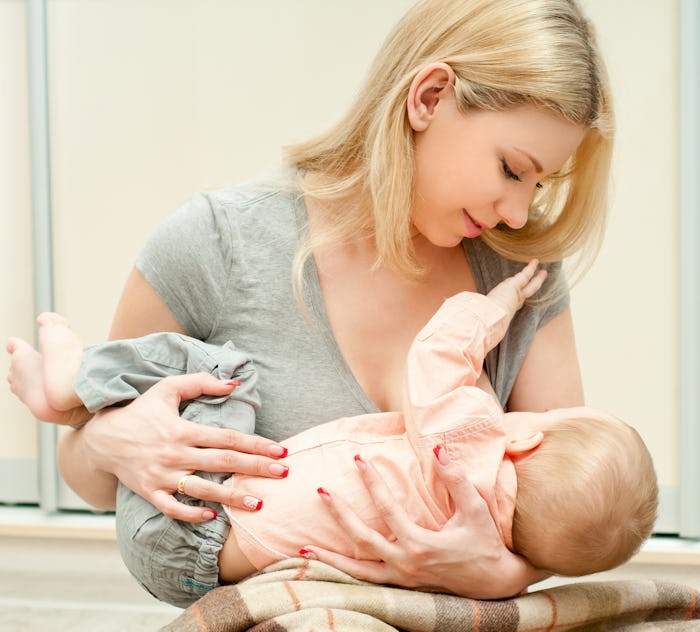Life

5 Ways To Soothe Your Boobs When Breastfeeding Hurts Like Hell
When I began breastfeeding my first baby, it was exactly what I’d imagined. My breasts swelled from an ample B cup to a pendulous D cup, heavy with milk and persistently sore from the pressure. And although it was uncomfortable in the beginning, it wasn’t so painful that I couldn’t work through it. Flash forward eight years later to my next baby, when I found myself crying from the pain and wondering what to do when breastfeeding hurts.
As it turns out, there is a lot you can do when breastfeeding hurts. After making a few adjustments, I was able to return to the pain-free nursing routine I remembered. And so can many other women. There are roadblocks that can cause many new moms to give up breastfeeding, but that doesn’t need to happen. Most new moms can breastfeed even if they encounter difficulties, with a little support and some knowledge. Luckily for me, I had resources, a helpful doctor, and the right information which kept my baby and me nursing happily after a few bumps in the road. If you are having difficulty, here are some common breastfeeding blocks and what you can do about them.
1Improper Baby Latch
The first place to look if your breasts are hurting is your baby’s latch. Breastfeeding Basics notes that improper latching techniques can cause very sore boobs, as the movement of the baby’s tongue and mouth will abrade your breast and nipple tissue. A basic check of your baby’s mouth positioning while nursing will go a long way toward successful and sore-free breastfeeding. First, check that your baby’s mouth is as wide open as possible before she attaches to your breast. Then, make sure her tongue, bottom lip, and chin touch your breast first. Once she is attached, check that her chin is touching your breast, and her nose is free. Her nose will still seem somewhat smashed into your boob, but there should be a tiny bit of space between her nostrils and your breast.
2Mastitis
In my case, mastitis was the culprit of my breast pain while breastfeeding. Mastitis is a bacterial breast duct infection that often comes with a fever;. Although I didn’t have a fever, my breast felt hot to the touch and burned while the baby was nursing. Ouch! Other symptoms of mastitis are a red, wedge shape on the breast and breast swelling (outside the norm of your already swollen breasts, that is.) Thankfully, a dose of antibiotics can cure this ailment.
3Thrush
Thrush stinks. I should know, because I grappled with thrush while also battling mastitis. Thrush is essentially a yeast infection that makes itself at home in your nipples, and it’s just as fun as it sounds. Which is zero —zero fun. As with a vaginal yeast infection, it hurts deep within your breast, and you feel pain whenever your baby sucks. You might also notice cracked or shining skin on your breast or nipples, redness, or a burning sensation.
You’ll want to visit your OB-GYN, who will need to look into your baby’s mouth and see if thrush is growing there.
La Leche League International notes that the first step to treating thrush is controlling it. To do that, you’ll need to wash everything — includes breast pads, nightgowns, shirts, and bras — in hot water. Rinsing your nipples with a vinegar and water solution (1 tablespoon vinegar to 1 cup water) after every feeding helps to kill off yeast. Use tissues or a fresh cotton ball for each application and mix a new solution each time. A combination of these tricks and antibiotics should do the trick in curing you of thrush.
4Flat Or Inverted Nipples
Women with flat or inverted nipples may experience pain and discomfort when trying to breastfeed, due to the difficulty of the nipple extending in order to fit properly in the baby’s mouth while breastfeeding. The best plan of action for women who are experiencing issues with flat or inverted nipples while breastfeeding is to contact your local La Leche League which offers tips as well as support to women who struggle with nipple-related breastfeeding issues.
5General Breastfeeding Pain
Breastfeeding is a biologically natural act, but that doesn’t always mean pain free. Especially in the beginning stages, breastfeeding can be uncomfortable, even if nothing is technically wrong. To make it more comfortable, placing a warm, wet rag on each breast is heaven. The heat and warmth soften your tissues and relieve pain. (But don’t do this if you think you have thrush!)
It also helps to give yourself breast massages in the shower. Or, even better, have your partner give them to you! As the warm water hits your breasts, massage each one in gentle, circular motions. This assists in clearing any potentially clogged milk ducts, and relieves pain from pressure. With some attention and care, breastfeeding can be comfortable and an irreplaceable bonding experience for you and your baby.
Images: Svetlana Fedoseeva/Fotolia; Giphy (5)